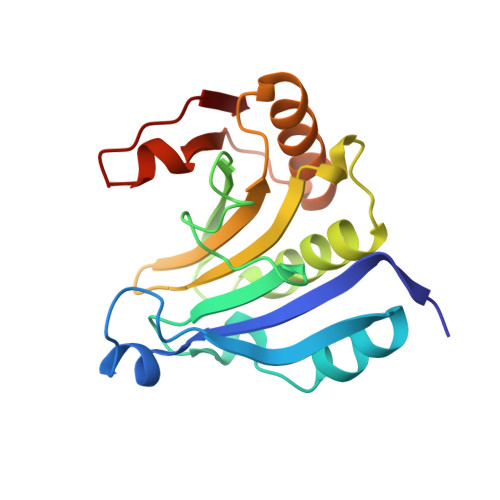Structure-Based Mutational Analysis of Eif4E in Relation to Sbm1 Resistance to Pea Seed-Borne Mosaic Virus in Pea.
Ashby, J.A., Stevenson, C.E., Jarvis, G.E., Lawson, D.M., Maule, A.J.(2011) PLoS One 6: E873
- PubMed: 21283665
- DOI: https://doi.org/10.1371/journal.pone.0015873
- Primary Citation of Related Structures:
2WMC - PubMed Abstract:
Pea encodes eukaryotic translation initiation factor eIF4E (eIF4E(S)), which supports the multiplication of Pea seed-borne mosaic virus (PSbMV). In common with hosts for other potyviruses, some pea lines contain a recessive allele (sbm1) encoding a mutant eIF4E (eIF4E(R)) that fails to interact functionally with the PSbMV avirulence protein, VPg, giving genetic resistance to infection. To study structure-function relationships between pea eIF4E and PSbMV VPg, we obtained an X-ray structure for eIF4E(S) bound to m(7)GTP. The crystallographic asymmetric unit contained eight independent copies of the protein, providing insights into the structurally conserved and flexible regions of eIF4E. To assess indirectly the importance of key residues in binding to VPg and/or m(7)GTP, an extensive range of point mutants in eIF4E was tested for their ability to complement PSbMV multiplication in resistant pea tissues and for complementation of protein translation, and hence growth, in an eIF4E-defective yeast strain conditionally dependent upon ectopic expression of eIF4E. The mutants also dissected individual contributions from polymorphisms present in eIF4E(R) and compared the impact of individual residues altered in orthologous resistance alleles from other crop species. The data showed that essential resistance determinants in eIF4E differed for different viruses although the critical region involved (possibly in VPg-binding) was conserved and partially overlapped with the m(7)GTP-binding region. This overlap resulted in coupled inhibition of virus multiplication and translation in the majority of cases, although the existence of a few mutants that uncoupled the two processes supported the view that the specific role of eIF4E in potyvirus infection may not be restricted to translation. The work describes the most extensive structural analysis of eIF4E in relation to potyvirus resistance. In addition to defining functional domains within the eIF4E structure, we identified eIF4E alleles with the potential to convey novel virus resistance phenotypes.
- Department of Biochemistry, University of Cambridge, Cambridge, United Kingdom.
Organizational Affiliation:

















